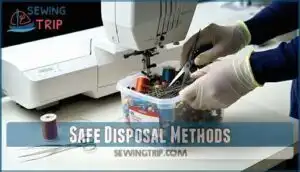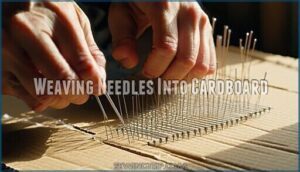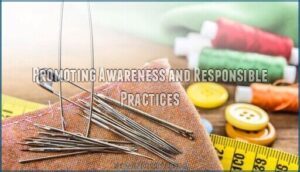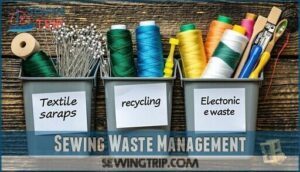This site is supported by our readers. We may earn a commission, at no cost to you, if you purchase through links.
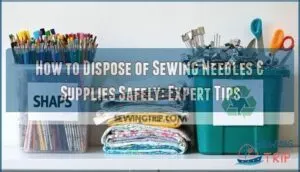
Don’t toss these items loose in regular trash bags. For fabric scraps, donate usable pieces to schools, quilting groups, or craft centers instead of sending them to landfills.
Metal components like broken machine parts should go to scrap metal recycling facilities. Synthetic threads and materials need special handling since they persist in the environment for decades.
Always check your local waste management guidelines for specific disposal requirements, as regulations vary by location. The key is separating your sewing waste by material type and recyclability—this simple step transforms potential hazards into responsible environmental practices that benefit your entire community.
Table Of Contents
Key Takeaways
- Use puncture-proof containers for needles – Don’t toss sharp needles loose in trash bags. Use heavy-duty containers like detergent bottles, fill only three-quarters full, seal with tape, and label "SHARPS—DO NOT RECYCLE" to protect sanitation workers.
- Separate materials by type for proper disposal – Sort your sewing waste into categories: take metal components to scrap recycling facilities, donate usable fabric scraps to schools or craft centers, and handle synthetic materials through special waste programs.
- Check your local waste management guidelines – Contact your municipality before disposing of sewing supplies since regulations vary by location. Many areas have specific requirements for sharp objects and offer specialized recycling programs.
- Transform disposal into donation opportunities – Instead of throwing away usable supplies, donate fabric scraps to quilting groups, give working sewing machines to schools, and repurpose old notions for craft projects to reduce landfill waste.
Sewing Disposal Basics
Proper disposal of sewing needles and supplies protects sanitation workers, family members, and the environment from sharp puncture wounds and contamination.
Improper needle disposal creates serious safety hazards, including injury risks and environmental pollution that affects entire communities, posing a threat to entire communities.
Importance of Proper Disposal
Proper sewing waste disposal protects your family and community from injury while supporting environmental care.
Sharp needles can puncture trash bags, endangering sanitation workers and creating liability issues.
Sustainable practices like sewing supply recycling and eco-friendly disposal methods reduce landfill burden.
Implementing waste reduction strategies for fabric scraps and textile waste management demonstrates responsible crafting that benefits everyone.
Risks of Improper Disposal
Improper sewing needle disposal creates serious hazards that you can’t afford to ignore.
Sharp needles threaten sanitation workers and communities—disposal matters
Sharp needles pose immediate dangers while synthetic materials contribute to long-term environmental damage through toxic waste accumulation.
- Health Risks – Needles cause puncture wounds and potential infections in sanitation workers
- Sewage Pollution – Metal needles damage treatment facilities and contaminate water systems
- Ecological Damage – Synthetic threads persist in landfills for decades
- Environmental Harm – Fabric scraps release microplastics into soil and waterways
- Textile Waste Management – Overflowing disposal systems increase contamination risks
Environmental Impact
When you toss sewing supplies carelessly into regular trash, landfills become overcrowded with non-biodegradable materials that persist for decades.
Embracing eco friendly disposal methods protects ecosystems while supporting sustainable sewing practices through proper waste reduction.
- Fabric scrap disposal through textile recycling programs diverts tons of material from landfills annually
- Sewing machine recycling recovers valuable metals and components for reuse in new products
- Environmental awareness drives green practices that make fabric recycling centers increasingly accessible nationwide
By adopting a reduce waste mindset, sewers can substantially minimize their environmental footprint and contribute to a more sustainable future.
How to Dispose Sewing
Disposing of sewing materials requires systematic planning to protect both people and the environment. When your creative sanctuary becomes cluttered with remnants, establishing clear disposal protocols prevents accidents and reduces environmental impact.
Thread disposal methods vary by material composition, while fabric scrap disposal depends on textile type and condition.
- Sewing waste segregation: Sort materials by recyclability – separate metal components like pins and scissors from organic fabrics and synthetic threads for appropriate processing channels
- Eco friendly alternatives: Transform fabric disposal into creative opportunities by donating usable scraps to schools, quilting groups, or craft centers rather than sending them to landfills
- Sewing machine recycling preparation: Clean and document machine condition, research local electronics recycling programs, and remove any hazardous materials before disposal
Thread recycling programs accept natural fibers more readily than synthetic blends. Your sewing room organization should include designated containers for different waste streams.
Sewing supply donation centers welcome gently used notions, while sewing needle disposal requires puncture-proof containers to guarantee handler safety throughout the disposal chain.
Safe Disposal Methods
When disposing of sewing needles and supplies, you’ll need to follow specific safety protocols to protect sanitation workers and the environment.
The key lies in understanding your local waste management guidelines and implementing proper containment methods before disposal.
Checking Local Guidelines
Contact your local waste management authority before sewing needle disposal to understand specific Government Rules and Community Standards.
Many municipalities have unique Waste Policies governing sharp objects, while some areas offer sewing supply donation programs or sewing material recycling services.
Your city’s website typically outlines Local Ordinances for proper disposal methods.
This Regulation Research prevents violations and makes certain you’re following established protocols for safe waste handling.
When handling sharp objects like sewing needles, this is vital for preventing accidents and damage, and you must delicate fabric safety to prevent accidents and damage.
Recycling and Reusing Metal Supplies
Metal recycling transforms your used sewing supplies into valuable resources while supporting sustainable supply chains.
Take scissors, pins, and machine parts to local scrap management facilities where they’ll pay by weight.
These eco-friendly practices reduce manufacturing costs by 85% for copper items and 95% for aluminum components.
Your sewing tool disposal contributes to circular sewing equipment disposal systems, turning yesterday’s materials into tomorrow’s sustainable metals through efficient sewing kit recycling programs.
By adopting eco friendly sewing methods, sewers can substantially minimize their environmental footprint.
Creative Disposal Ideas for Sewing Needles
Beyond recycling programs, you can transform used needles into creative projects while maintaining sewing safety. Old needles become decorative elements in mixed media artwork or jewelry pieces when handled properly.
These craft reuse approaches prevent fabric waste while supporting eco friendly practices. To guarantee safety, it’s vital to follow proper needle disposal methods when handling sharp objects.
- Create needle books using felt scraps to store dull needles as functional art
- Embed needles in shadow boxes with thimbles and buttons for sewing memorabilia
- Bundle wrapped needles into decorative "bouquets" tied with ribbons for keepsakes
- Design wind chimes by suspending secured needles from upcycled hoops
Responsible Needle Disposal
Proper needle disposal prevents accidental injuries and protects waste management workers from sharp puncture wounds.
You’ll need specific containers and techniques to safely dispose of these small but hazardous sewing tools, ensuring proper disposal methods are followed.
Using Containers for Storage
Repurpose heavy-duty plastic containers like detergent bottles or prescription medicine bottles for needle storage.
Fill containers only three-quarters full, then seal with duct tape.
Add Container Labels reading "SHARPS—DO NOT RECYCLE" to protect waste handlers.
Store organized shelves away from children and pets, keeping Storage Bins puncture-resistant and leak-proof for maximum safety.
When selecting containers, consider using materials with high puncture resistant properties to guarantee safe storage.
Weaving Needles Into Cardboard
You can create a safe needle disposal system by weaving used needles into thick cardboard.
This cardboard weaving technique involves pushing sharp needles through corrugated material, securing them completely inside.
The eco friendly method transforms old sewing disposal into creative needle safety storage.
Once filled, dispose of the entire cardboard piece safely, making needle recycling simple and effective.
When traveling with sewing supplies, to guarantee compliance and safe transportation, understand TSA rules on sewing needles to make certain you’re aware of the regulations.
Promoting Awareness and Responsible Practices
Sharing your needle disposal knowledge helps build safer sewing communities.
Encourage sustainable sewing practices through social media posts about eco friendly disposal methods.
Start conversations about sewing safety and waste reduction at local craft groups.
Your community outreach efforts can inspire others to adopt responsible old sewing disposal habits, creating ripple effects that protect both people and the environment.
Sewing Waste Management
Managing sewing waste effectively protects both your household and the environment from potential hazards.
You’ll need to think about specific disposal methods for different materials, from metal needles to fabric scraps and electronic components, including considering environmental impacts.
Encouraging Responsible Practices
Foster sustainable sewing practices by organizing community workshops on sewing pattern recycling and fabric reuse.
You’ll build eco-friendly networks while teaching waste reduction techniques. Engage neighbors through green practices demonstrations, showcasing yarn waste disposal methods and creative sewing scrap reuse.
When you dispose of materials responsibly, others follow suit. Community engagement transforms individual efforts into collective environmental impact.
By adopting a reduce waste mindset, individuals can make a significant difference in promoting eco-friendly sewing habits, and contribute to a larger environmental impact through community engagement.
Social Media Promotion
Leverage influencer marketing and content creation to amplify your message about proper sewing needle disposal.
Document your sewing scrap reuse projects and yarn waste disposal methods through engaging posts that boost brand awareness.
Online engagement grows when you share creative sewing pattern recycling ideas and fabric reuse techniques, transforming individual responsibility into community-wide action.
Social sharing inspires others to dispose of sewing materials safely, making community-wide action and proper disposal essential for a collective impact.
Proper Disposal of Sewing Machines and Fabrics
When disposing of bulky sewing equipment and textile waste, prioritize sustainable practices that benefit both environment and community.
Follow these essential steps:
- Sewing machine donation to schools or community centers extends equipment life
- Sewing machine recycling through certified e-waste programs recovers valuable metals
- Fabric waste sorting by material type maximizes textile disposal efficiency
- Eco friendly sewing practices include composting natural fiber scraps
- Sustainable crafting involves creative fabric reuse for new projects
Proper waste management transforms disposal challenges into environmental opportunities.
Frequently Asked Questions (FAQs)
How to dispose of unwanted fabric?
Americans discard 11 million tons of textiles yearly, yet you’ve got better options than tossing fabric scraps.
Donate usable pieces to local shelters, schools, or crafting groups.
Cut damaged fabric into cleaning rags or compost pure cotton materials for eco-friendly disposal.
Where is the best place to dispose of used needles?
You’ll want to dispose of used sewing needles safely in a sharps container or puncture-proof container, then take it to a pharmacy, hospital, or medical waste facility for proper disposal.
How to throw away a sewing machine?
Contact your local recycling center to see if they accept electronics.
Many offer e-waste programs for appliances.
You can also donate working machines to thrift stores or schools, or check manufacturer take-back programs.
What do you do with an old sewing machine that doesn’t work?
Seventy percent of discarded sewing machines end up in landfills unnecessarily.
You can donate your broken machine to repair shops, vocational schools, or crafters who salvage parts.
Check with local recycling centers for proper electronic waste disposal options, and consider donate as a viable alternative to landfill disposal.
How to get rid of a broken sewing machine?
You can donate working machines to charities, sell functional ones online, or recycle through electronics programs.
For truly broken machines, contact local waste management about metal recycling or appliance disposal services.
Can sewing thread go in regular recycling bins?
Sewing thread’s like confetti at a party – colorful but messy when mixed with recyclables.
No, thread can’t go in regular recycling bins because it tangles machinery and contaminates paper streams.
What about disposing of broken sewing scissors?
Broken sewing scissors can’t go in regular recycling due to mixed materials. Check if local scrap metal yards accept them, or wrap sharp blades safely before trash disposal.
How do you handle contaminated fabric scraps?
Don’t panic about contaminated fabric scraps—they’re manageable with proper precautions.
Wear gloves, seal scraps in plastic bags, and dispose through regular trash or contact local hazardous waste facilities for guidance.
Are vintage sewing notions considered hazardous waste?
Most vintage sewing notions aren’t hazardous waste, but check for lead-based paints on old items, mercury in antique measuring tools, and asbestos in pressing aids before disposal.
Can old patterns be composted or recycled?
Most old sewing patterns can’t be recycled due to tissue paper material and ink combinations. You can compost uncoated patterns, but remove plastic packaging first. Consider donating usable patterns instead.
Conclusion
Like a compass guiding travelers through treacherous terrain, proper sewing disposal protects both people and planet from harm.
You’ve learned how to dispose of sewing materials safely—from using puncture-proof containers for needles to donating fabric scraps.
Remember, each sharp tool requires careful containment, while metals deserve recycling facilities.
Your local waste management guidelines provide the final roadmap.
By separating materials thoughtfully and following these expert techniques, you’ll transform potential hazards into responsible environmental stewardship that safeguards your community, promoting environmental stewardship.
- https://www.sewnapart.com/textile-composting
- https://www.reddit.com/r/sewing/comments/t1vj2g/any_ideas_for_recycling_or_reusing_thread_waste/
- https://checksammy.com/blog/fabric-scrap-recycling-5-options/
- https://www.asg.org/what-do-you-do-with-fabric-scraps/
- https://fashion.sustainability-directory.com/question/what-is-textile-waste-composting/

